A Novel Power Distribution Strategy and Its Online Implementation for Hybrid Energy Storage Systems of Electric Vehicles
Abstract
1. Introduction
2. HESS Model
3. A Novel Power Distribution Strategy
3.1. Power Distribution Model of the UC
- (1)
- P ≥ 0 (the vehicle is powered by HESS)
- (2)
- P < 0 (the vehicle regenerates energy to the HESS)
3.2. Optimization of the Model Parameters
4. Online Application of the PSO-Based Strategy
4.1. Selection of Characteristic Parameters
4.2. Driving Condition Recognition Based on a Neural Network
5. Results and Comparisons
5.1. Results under UDDS
5.2. Comparisons of Different Methods
- (1)
- Comparisons with the rule-based strategy
- (2)
- Comparisons with the strategy based on offline PSO
6. Conclusions
Author Contributions
Funding
Conflicts of Interest
References
- Somakumar, R.; Kasinathan, P.; Monicka, G.; Rajagopalan, A.; Ramachandaramurthy, V.; Subramaniam, U. Optimization of emission cost and economic analysis for microgrid by considering a metaheuristic algorithm-assisted dispatch model. Int. J. Numer. Model. Electron. Netw. Device Fields 2022, 35, e2993. [Google Scholar] [CrossRef]
- Devendiran, R.; Kasinathan, P.; Ramachandaramurthy, V.; Subramaniam, U.; Govindarajan, U.; Fernando, X. Intelligent optimization for charging scheduling of electric vehicle using exponential Harris Hawks technique. Int. J. Intell. Syst. 2021, 36, 5816–5844. [Google Scholar] [CrossRef]
- Wang, J.; Liu, P.; Garner, J.; Sherman, E.; Soukiazian, S.; Verbrugge, M.; Tataria, H.; Musser, J.; Finamore, P. Cycle-life model for graphite-LiFePO4 cells. J. Power Source 2011, 196, 3942–3948. [Google Scholar] [CrossRef]
- Lybbert, M.; Ghaemi, Z.; Balaji, A.; Warren, R. Integrating life cycle assessment and electrochemical modeling to study the effects of cell design and operating conditions on the environmental impacts of lithium-ion batteries. Renew. Sustain. Energy Rev. 2021, 144, 111004. [Google Scholar] [CrossRef]
- Motapon, S.; Lachance, E.; Dessaint, L.; Haddad, K. A generic cycle life model for lithium-ion batteries based on fatigue theory and equivalent cycle counting. IEEE Open J. Ind. Electron. Soc. 2020, 1, 207–217. [Google Scholar] [CrossRef]
- Shen, D.; Wu, L.; Kang, G.; Guan, Y.; Peng, Z. A novel online method for predicting the remaining useful life of lithium-ion batteries considering random variable discharge current. Energy 2021, 218, 119490. [Google Scholar] [CrossRef]
- Liu, C.; Wang, Y.; Chen, Z. Degradation model and cycle life prediction for lithium-ion battery used in hybrid energy storage system. Energy 2019, 166, 796–806. [Google Scholar] [CrossRef]
- Rezaei, H.; Abdollahi, S.; Abdollahi, S.; Filizadeh, S. Energy management strategies of battery-ultracapacitor hybrid storage systems for electric vehicles: Review, challenges, and future trends. J. Energy Storage 2022, 53, 105045. [Google Scholar] [CrossRef]
- Wang, C.; Liu, R.; Tang, A. Energy management strategy of hybrid energy storage system for electric vehicles based on genetic algorithm optimization and temperature effect. J. Energy Storage 2022, 51, 104314. [Google Scholar] [CrossRef]
- Xu, N.; Kong, Y.; Chu, L.; Ju, H.; Yang, Z.; Xu, Z.; Xu, Z. Towards a smarter energy management system for hybrid vehicles: A comprehensive review of control strategies. Appl. Sci. 2019, 9, 2026. [Google Scholar] [CrossRef]
- Carter, R.; Cruden, A.; Hall, P.J. Optimizing for efficiency or battery life in a battery/supercapacitor electric vehicle. IEEE Trans. Veh. Technol. 2012, 61, 1526–1533. [Google Scholar] [CrossRef]
- Gautam, A.K.; Tariq, M.; Pandey, J.P.; Verma, K.S. Optimal power management strategy by using fuzzy logic controller for BLDC Motor-Driven E-Rickshaw. J. Intell. Fuzzy Syst. 2022, 42, 1089–1098. [Google Scholar] [CrossRef]
- Salari, O.; Zaad, K.H.; Bakhshai, A.; Youssef, M.Z.; Jain, P. A systematic approach for the design of the digital low pass filters for energy storage systems in EV applications. IEEE J. Emerg. Sel. Top. Ind. Electron. 2020, 1, 67–79. [Google Scholar] [CrossRef]
- Shi, J.; Xu, B.; Zhou, X.; Hou, J. A cloud-based energy management strategy for hybrid electric city bus considering real-time passenger load prediction. J. Energy Storage 2022, 45, 103749. [Google Scholar] [CrossRef]
- Zhai, C.; Luo, F.; Liu, Y. A novel predictive energy management strategy for electric vehicles based on velocity prediction. IEEE Trans. Veh. Technol. 2020, 69, 12559–12569. [Google Scholar] [CrossRef]
- Song, Z.; Hofmann, H.; Li, J.; Han, X.; Ouyang, M. Optimization for a hybrid energy storage system in electric vehicles using dynamic programing approach. Appl. Energy 2015, 139, 151–162. [Google Scholar] [CrossRef]
- Li, X.; Han, L.; Liu, H.; Wang, W.; Xiang, C. Real-time optimal energy management strategy for a dual-mode power-split hybrid electric vehicle based on an explicit model predictive control algorithm. Energy 2019, 172, 1161–1178. [Google Scholar] [CrossRef]
- Wu, Y.; Huang, Z.; Hofmann, H.; Liu, Y.; Huang, J.; Hu, X.; Peng, J.; Song, Z. Hierarchical predictive control for electric vehicles with hybrid energy storage system under vehicle-following scenarios. Energy 2022, 251, 123774. [Google Scholar] [CrossRef]
- Wang, L.; Wang, Y.; Liu, C.; Yang, D.; Chen, Z. A power distribution strategy for hybrid energy storage system using adaptive model predictive control. IEEE Trans. Power Electron. 2020, 35, 5897–5906. [Google Scholar] [CrossRef]
- Yu, H.; Dezza, F.C.; Cheli, F.; Tang, X.; Hu, X.; Lin, X. Dimensioning and power management of hybrid energy storage systems for electric vehicles with multiple optimization criteria. IEEE Trans. Power Electron. 2021, 36, 5545–5556. [Google Scholar] [CrossRef]
- Angundjaja, C.Y.; Wang, Y.; Jiang, W. Power management for connected EVs using a fuzzy logic controller and artificial neural network. Appl. Sci. 2022, 12, 52. [Google Scholar] [CrossRef]
- Yu, S.; Lin, D.; Sun, Z.; He, D. Efficient model predictive control for real-time energy optimization of battery-supercapacitors in electric vehicles. Int. J. Energy Res. 2020, 44, 7495–7506. [Google Scholar] [CrossRef]
- Xiong, R.; Chen, H.; Wang, C.; Sun, F. Towards a smarter hybrid energy storage system based on battery and ultracapacitor—A critical review on topology and energy management. J. Clean Prod. 2018, 202, 1228–1240. [Google Scholar] [CrossRef]
- Bobba, P.; Rajagopal, K. Modeling and analysis of hybrid energy storage systems used in electric vehicles. In Proceedings of the IEEE International Conference on Power Electronics, Drives and Energy Systems (PEDES), Bengaluru, India, 16–19 December 2012. [Google Scholar]
- Naseri, F.; Farjah, E.; Ghanbari, T.; Kazemi, Z.; Schaltz, E.; Schanen, J.L. Online parameter estimation for supercapacitor state-of-energy and state-of-health determination in vehicular applications. IEEE Trans. Ind. Electron. 2020, 67, 7963–7972. [Google Scholar] [CrossRef]
- Eberhart, R.; Kennedy, J. A new optimizer using particle swarm theory. In Proceedings of the Sixth International Symposium on Micro Machine and Human Science, Nagoya, Japan, 4–6 October 1995. [Google Scholar]
- Shen, J.; Khaligh, A. A supervisory energy management control strategy in a battery/ultracapacitor hybrid energy storage system. IEEE Trans. Transp. Electrif. 2015, 1, 223–231. [Google Scholar] [CrossRef]
- Gomozov, O.; Trovão, J.; Kestelyn, X.; Dubois, M. Adaptive energy management system based on a real-time model predictive control with nonuniform sampling time for multiple energy storage electric vehicle. IEEE Trans. Veh. Technol. 2017, 66, 5520–5530. [Google Scholar] [CrossRef]
- Samani, H.; Fermando, X. Battery current’s fluctuations removal in hybrid energy storage system based on optimized control of supercapacitor voltage. IEEE Embed. Syst. Lett. 2016, 8, 53–56. [Google Scholar] [CrossRef]
- Carlson, T.R.; Austin, T.C. Development of Speed Correction Cycles; Sierra Research, Inc.: Sacramento, CA, USA, 1997. [Google Scholar]
- Langari, R.; Won, J.S. Intelligent energy management agent for a parallel hybrid vehicle—Part I: System architecture and design of the driving situation identification process. IEEE Trans. Veh. Technol. 2005, 54, 925–934. [Google Scholar] [CrossRef]
- Ericsson, E. Independent driving pattern factors and their influence on fuel-use and exhaust emission factors. Transport. Res. Part D-Transport. Environ. 2001, 6, 325–345. [Google Scholar] [CrossRef]
- Park, J.; Chen, Z.; Kiliaris, L.; Kuang, M.L.; Masrur, M.A.; Phillips, A.M.; Murphey, Y.L. Intelligent vehicle power control based on machine learning of optimal control parameters and prediction of road type and traffic congestion. IEEE Trans. Veh. Technol. 2009, 58, 4741–4756. [Google Scholar] [CrossRef]
- Roess, R.P.; Prassas, E.S.; McShame, W.R. Traffic Engineering, 5th ed.; Pearson Education: Hoboken, HL, USA, 2019. [Google Scholar]
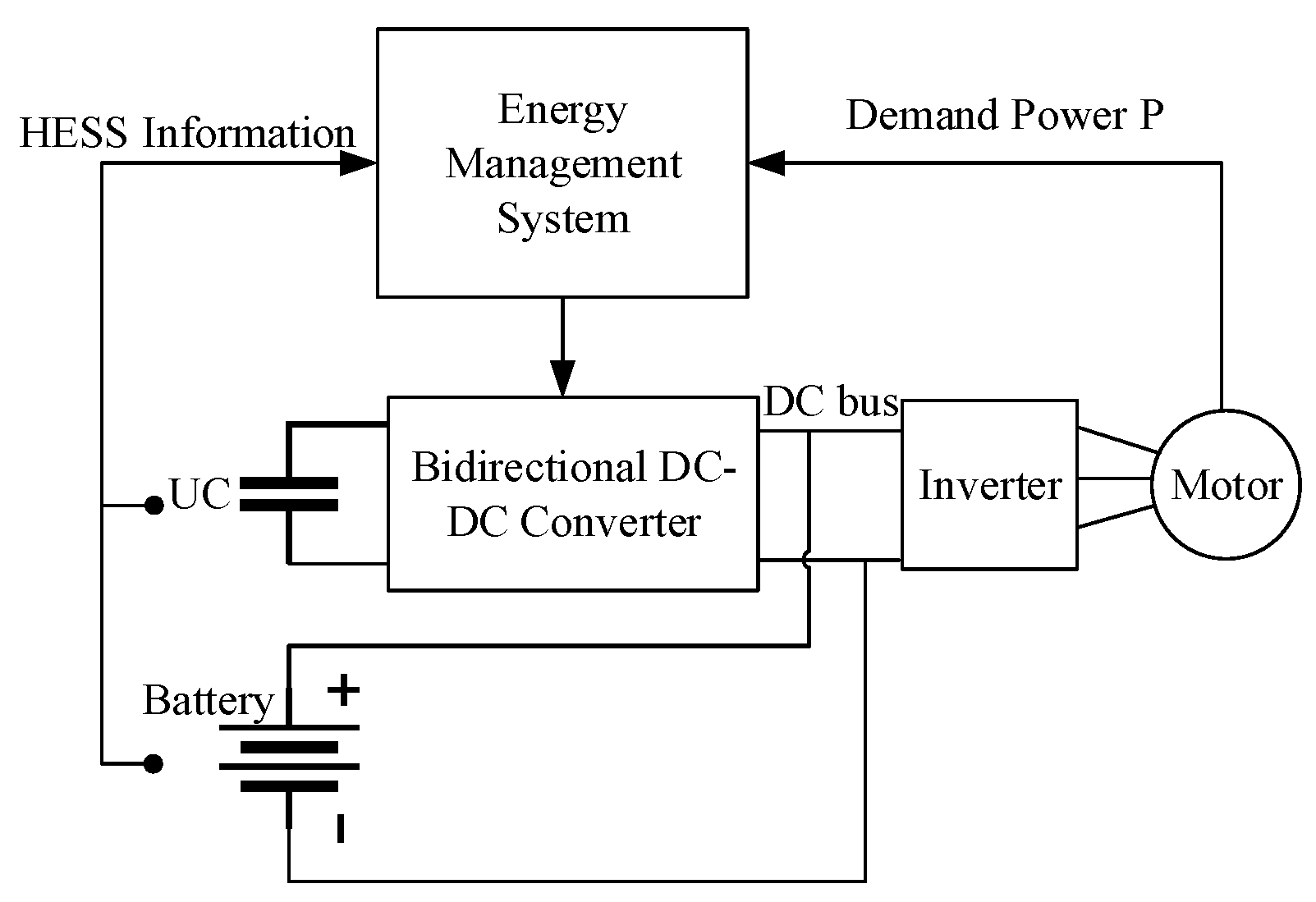


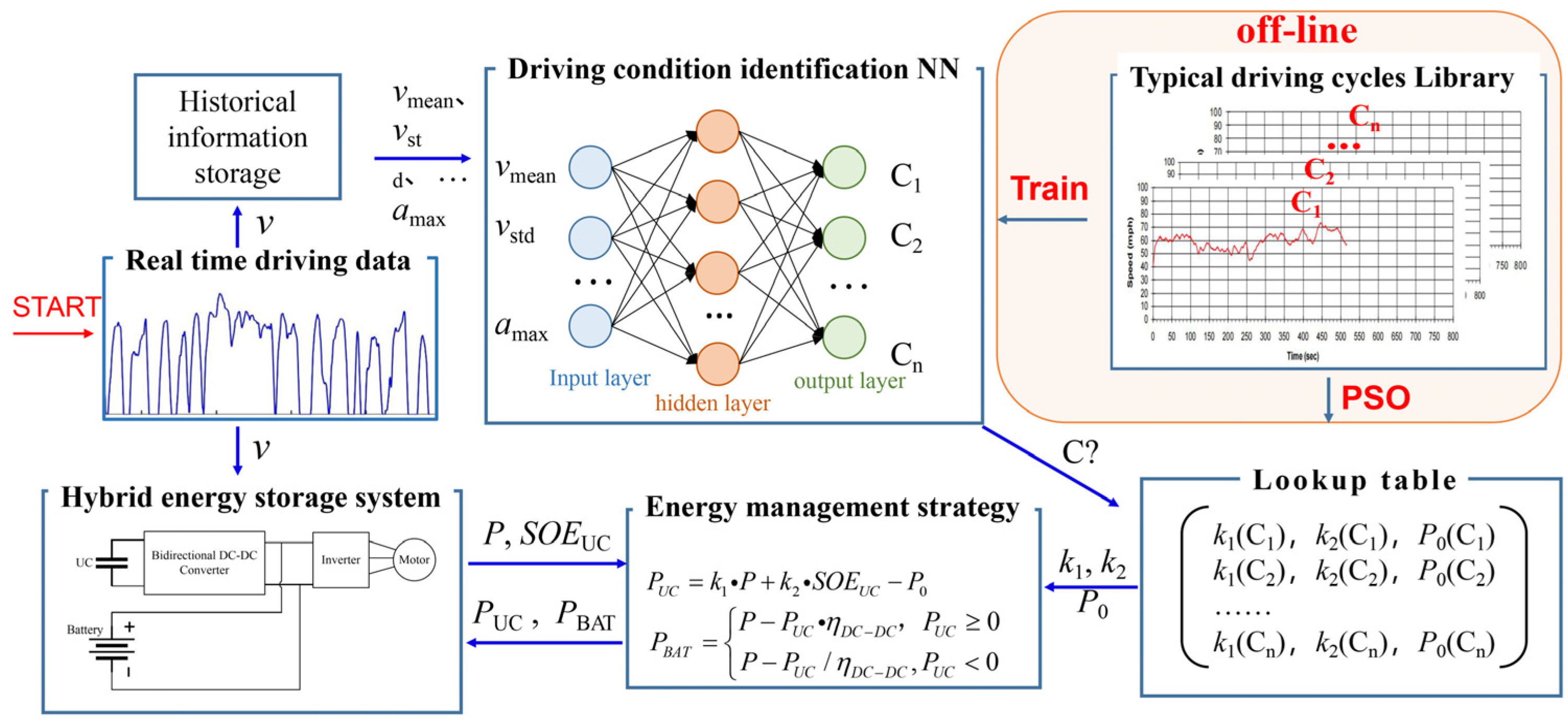

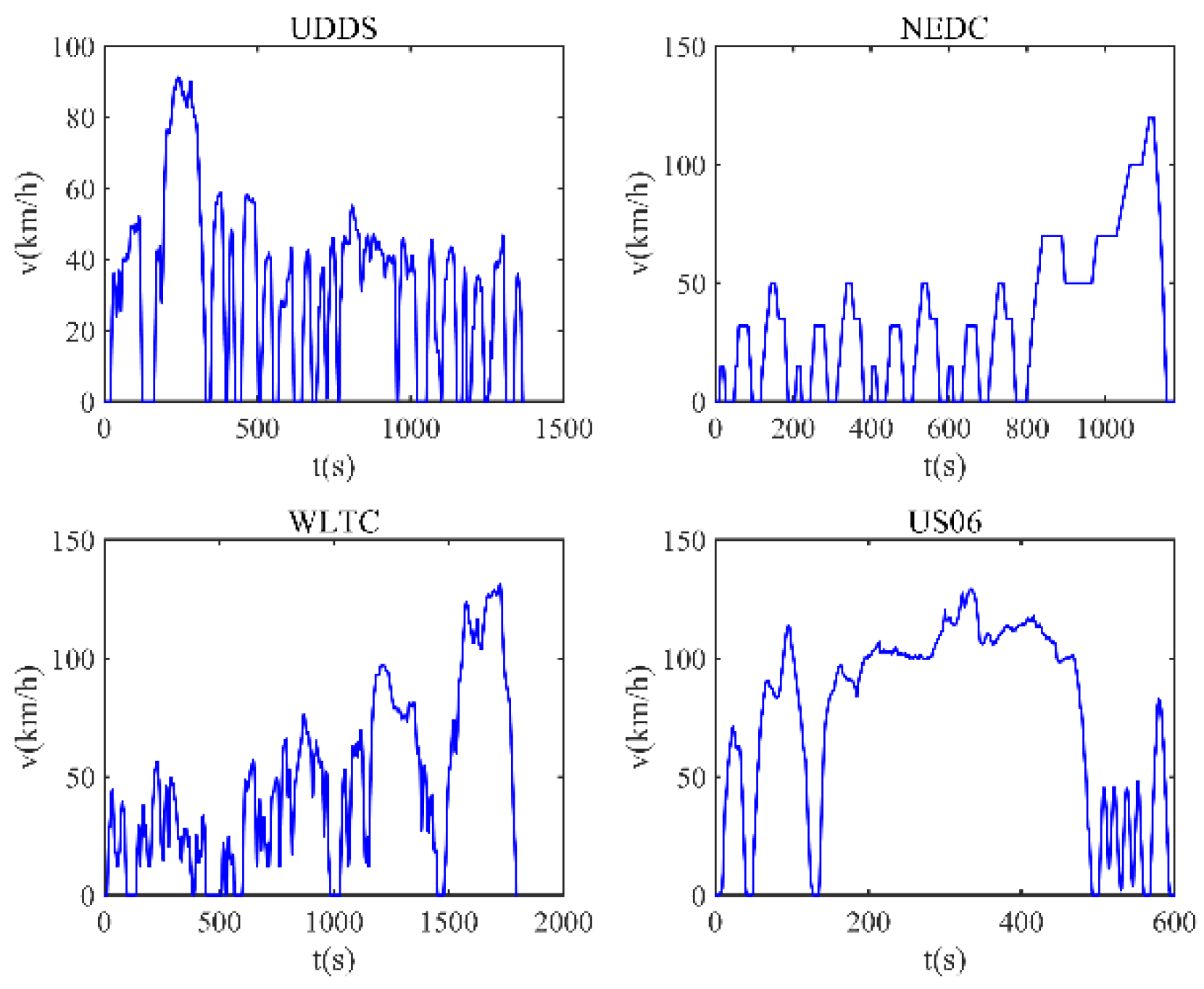
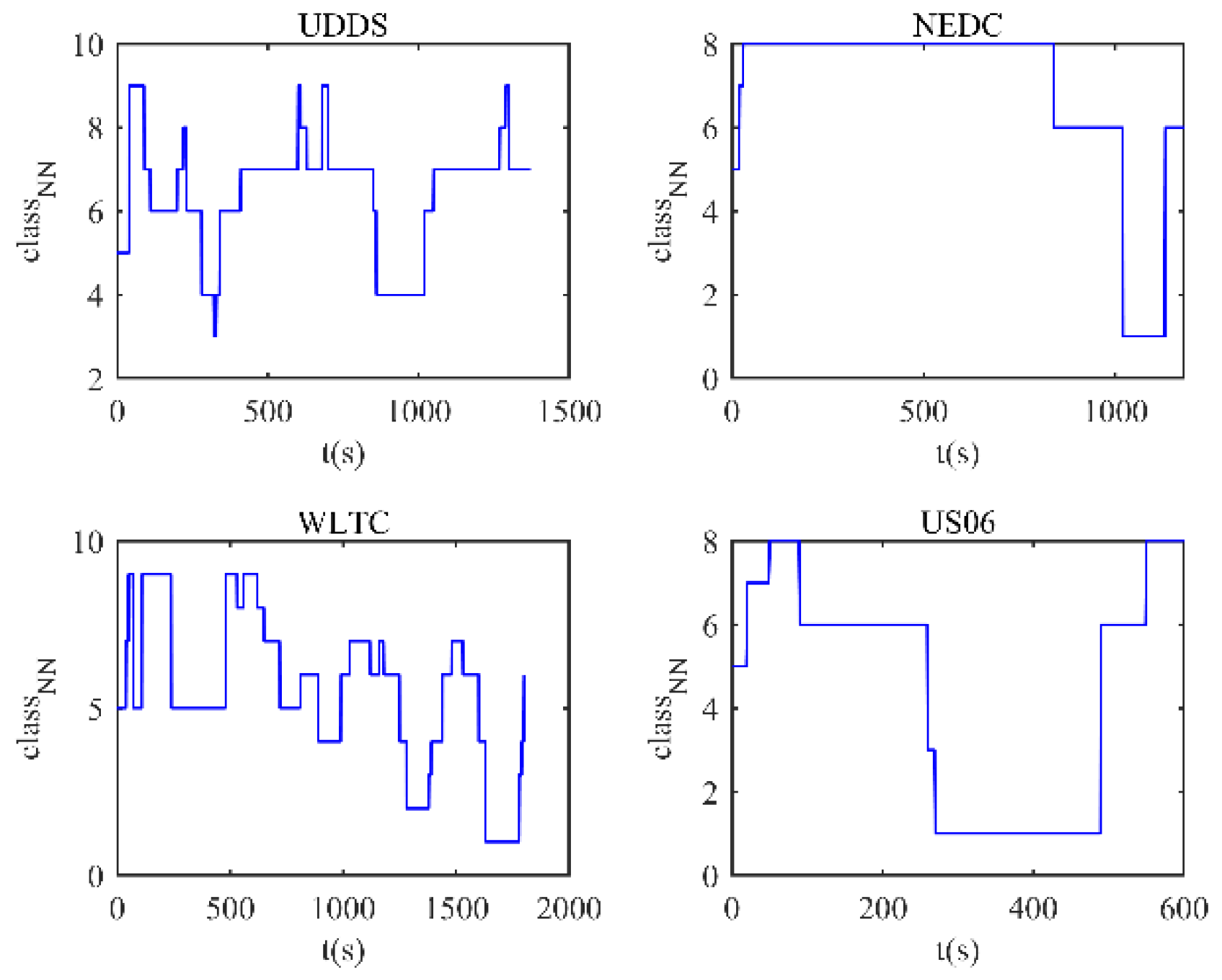
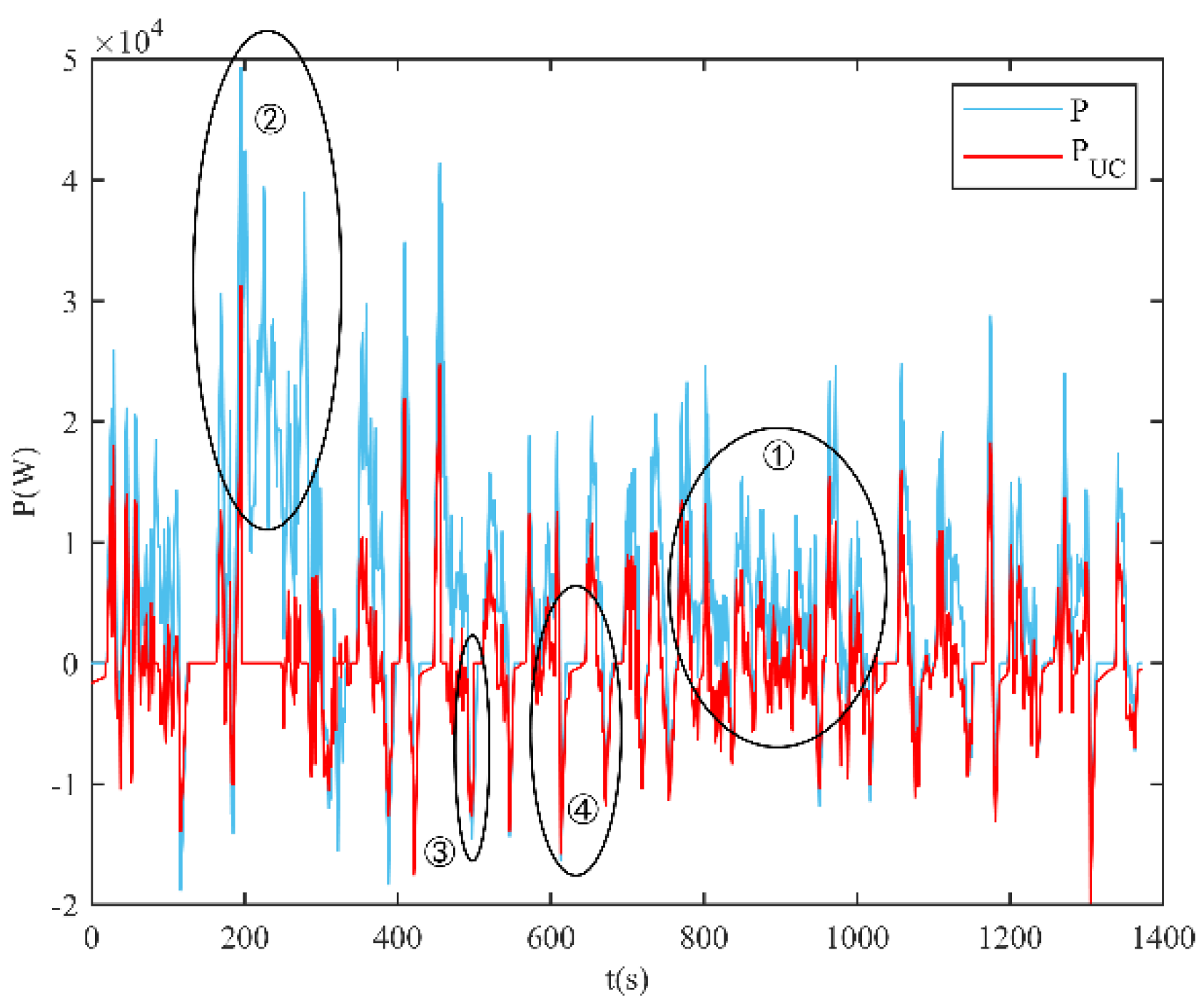
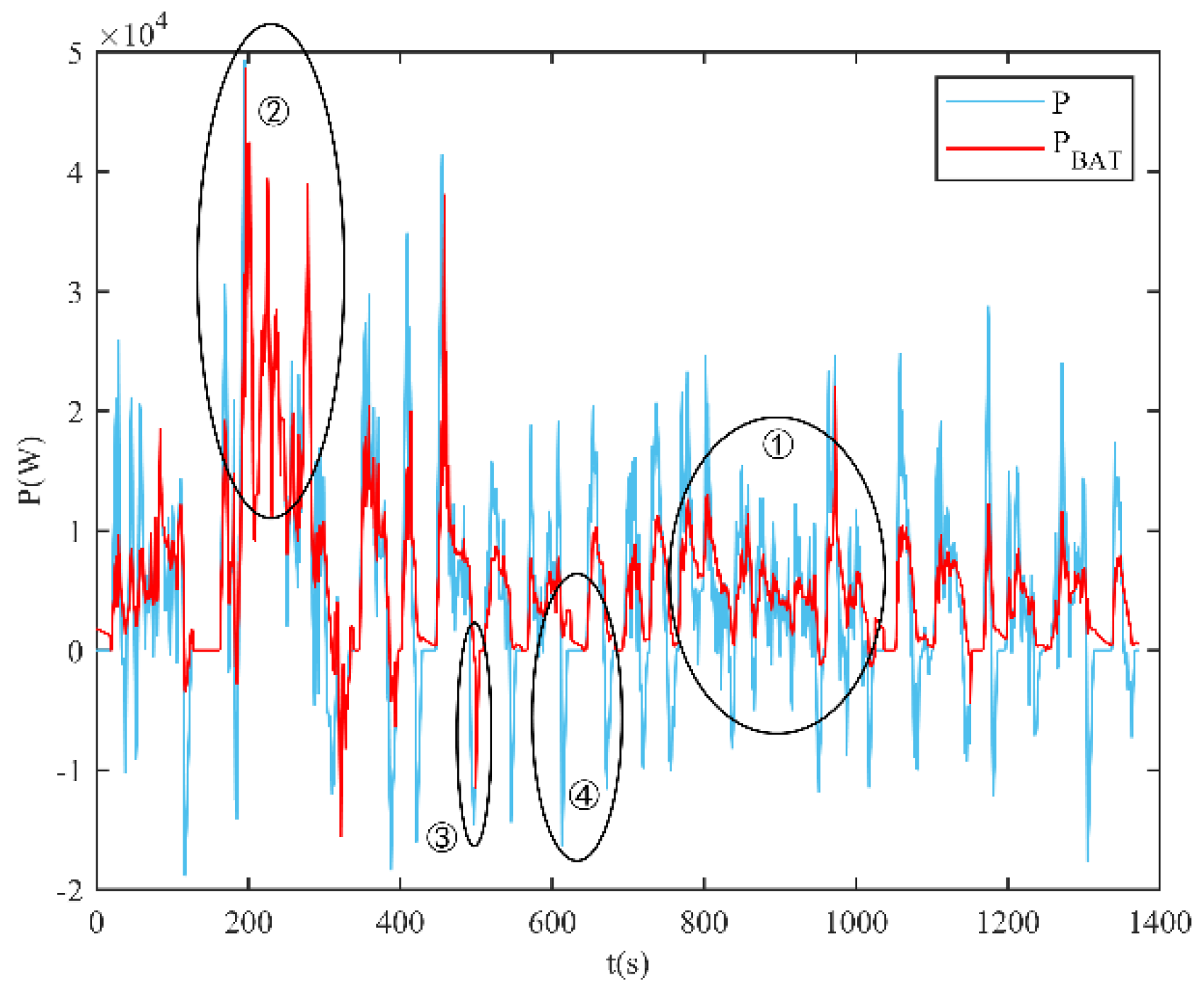
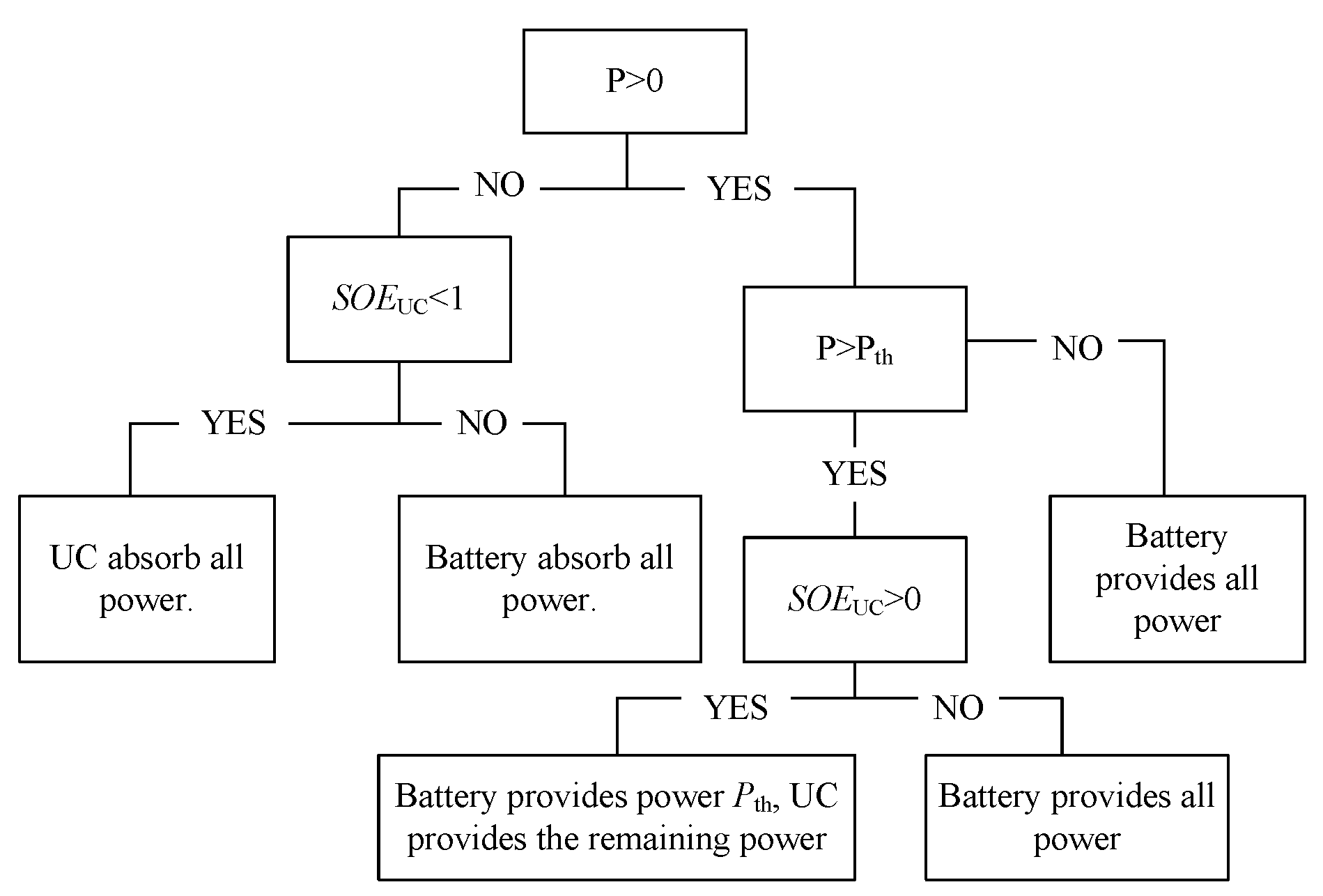
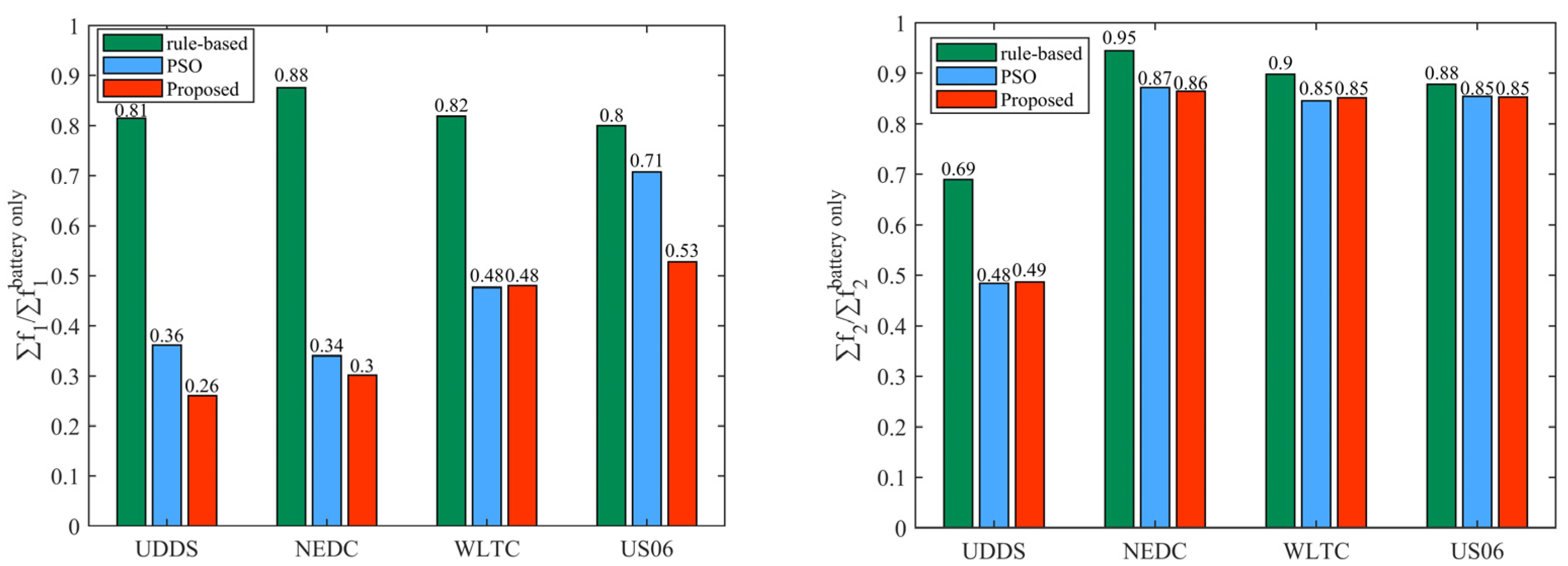
| Parameter | Value |
|---|---|
| m, Vehicle mass (kg) | 1500 |
| g, Gravitation acceleration (m/s2) | 9.8 |
| f, Rolling resistance coefficient | 0.015 |
| α, Grade of the road | 0 |
| ρ, Density of air (kg/m3) | 1.2258 |
| CD, Coefficient of air resistance | 0.4 |
| A, Windward area (m2) | 2.34 |
| δ, Correction coefficient of the rotation mass | 1.08 |
| Parameters of the Battery | Value | Parameters of the UC | Value |
|---|---|---|---|
| Cell nominal voltage (V) | 3.2 | Cell maximum voltage (V) | 2.7 |
| Cell capacity (Ah) | 60 | Cell rated capacitance (F) | 10 |
| Number of series | 112 | Number of series | 80 |
| Number of parallels | 3 | Number of parallels | 45 |
| Driving Cycle | vmean (km/h) | vmax (km/h) | Mileage (km) | Time (s) |
|---|---|---|---|---|
| Freeway High Speed | 101.71 | 119.74 | 17.25 | 610 |
| Freeway LOS A-C | 96.08 | 117.64 | 13.76 | 516 |
| Freeway LOS D | 85.13 | 113.62 | 9.59 | 406 |
| Freeway LOS E | 49.08 | 101.39 | 6.21 | 456 |
| Freeway LOS F | 29.93 | 80.31 | 3.69 | 442 |
| Freeway LOS “G” | 21.08 | 57.45 | 2.29 | 390 |
| Freeway Ramp | 55.68 | 96.88 | 4.12 | 266 |
| Arterial/Collectors LOS A-B | 39.91 | 94.79 | 8.16 | 737 |
| Arterial/Collectors LOS C-D | 30.90 | 79.66 | 5.41 | 629 |
| Arterial/Collectors LOS E-F | 18.67 | 64.21 | 2.61 | 504 |
| Local Roadways | 20.76 | 61.64 | 3.01 | 525 |
| Parameter | Description |
|---|---|
| vmax | Maximum Speed (km/h) |
| vmean | Mean Speed (km/h) |
| vstd | Speed Standard Deviation (km/h) |
| amax | Maximum Acceleration (m/s2) |
| amean | Mean Acceleration (m/s2) |
| rmean | Mean Deceleration (m/s2) |
| rmax | Maximum Deceleration (m/s2) |
| Rstop | Proportion of time when speed is equal to 0 |
| v0–15 | Proportion of time in the speed interval 0–15 km/h |
| v15–30 | Proportion of time in the speed interval 15–30 km/h |
| v90–110 | Proportion of time in the speed interval 90–110 km/h |
| vmax | vmean | vstd | amax | amean | rmean | rmax | Rstop | v0–15 | v15–30 | v90–100 | |
|---|---|---|---|---|---|---|---|---|---|---|---|
| F | 38.44 | 106.03 | 18.06 | 2.58 | 22.18 | 6.46 | 21.59 | 12.62 | 23.56 | 20.47 | 23.59 |
| PANOVA | 0 | 0 | 0 | 0.017 | 0 | 0 | 0 | 0 | 0 | 0 | 0 |
| Class | 0~120 s | 60~180 s | 120~240 s | 180~300 s | 240~360 s | 300~420 s | 360~480 s | 420~540 s | 480~600 s | 540~660 s | 600~720 s | |
|---|---|---|---|---|---|---|---|---|---|---|---|---|
| Time | ||||||||||||
| C1 | 1 | 1 | ② | ② | 1 | 1 | 1 | 1 | 1 | N/A | N/A | |
| C2 | 2 | 2 | 2 | 2 | 2 | 2 | 2 | N/A | N/A | N/A | N/A | |
| C3 | 3 | 3 | 3 | ② | 3 | N/A | N/A | N/A | N/A | N/A | N/A | |
| C4 | 4 | 4 | 4 | 4 | 4 | 4 | N/A | N/A | N/A | N/A | N/A | |
| C5 | 5 | 5 | 5 | 5 | 5 | 5 | N/A | N/A | N/A | N/A | N/A | |
| C6 | 6 | 6 | 6 | 6 | 6 | 6 | 6 | 6 | 6 | 6 | 6 | |
| C7 | 7 | 7 | 7 | 7 | 7 | 7 | 7 | 7 | 7 | N/A | N/A | |
| C8 | 8 | 8 | 8 | 8 | 8 | 8 | 8 | N/A | N/A | N/A | N/A | |
| C9 | 9 | 9 | 9 | ⑧ | 9 | 9 | 9 | N/A | N/A | N/A | N/A | |
Disclaimer/Publisher’s Note: The statements, opinions and data contained in all publications are solely those of the individual author(s) and contributor(s) and not of MDPI and/or the editor(s). MDPI and/or the editor(s) disclaim responsibility for any injury to people or property resulting from any ideas, methods, instructions or products referred to in the content. |
© 2023 by the authors. Licensee MDPI, Basel, Switzerland. This article is an open access article distributed under the terms and conditions of the Creative Commons Attribution (CC BY) license (https://creativecommons.org/licenses/by/4.0/).
Share and Cite
Jiang, N.; Wang, X.; Kang, L. A Novel Power Distribution Strategy and Its Online Implementation for Hybrid Energy Storage Systems of Electric Vehicles. Electronics 2023, 12, 301. https://doi.org/10.3390/electronics12020301
Jiang N, Wang X, Kang L. A Novel Power Distribution Strategy and Its Online Implementation for Hybrid Energy Storage Systems of Electric Vehicles. Electronics. 2023; 12(2):301. https://doi.org/10.3390/electronics12020301
Chicago/Turabian StyleJiang, Nanmei, Xuemei Wang, and Longyun Kang. 2023. "A Novel Power Distribution Strategy and Its Online Implementation for Hybrid Energy Storage Systems of Electric Vehicles" Electronics 12, no. 2: 301. https://doi.org/10.3390/electronics12020301
APA StyleJiang, N., Wang, X., & Kang, L. (2023). A Novel Power Distribution Strategy and Its Online Implementation for Hybrid Energy Storage Systems of Electric Vehicles. Electronics, 12(2), 301. https://doi.org/10.3390/electronics12020301






